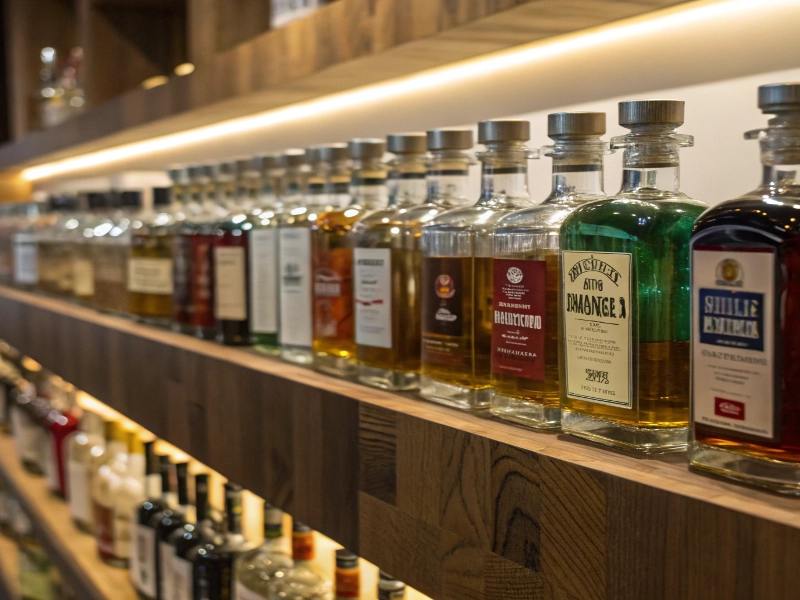
Ever stood in your production room staring at bottle samples, wondering if your size choice might be killing your margins? I’ve watched countless brands stumble simply because they picked the wrong bottle size without thinking it through.
Spirit bottles come in several standard industry sizes: 50ml (miniatures), 200ml, 375ml (pints), 750ml (fifths), 1L, and 1.75L (handles). Each size serves specific market needs, from sampling to value purchases, with profound impacts on your brand positioning, cost structure, and distribution strategy.
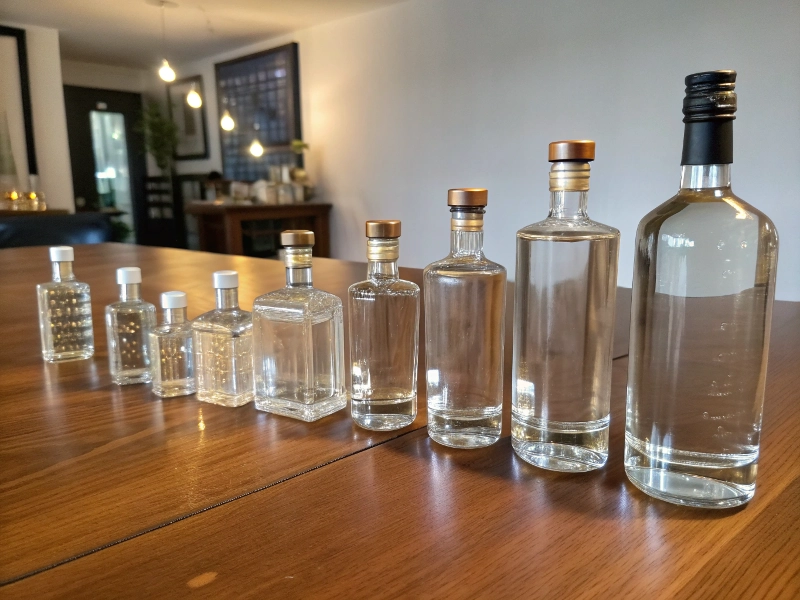
After 15+ years working with spirit brands on packaging, I’ve learned that bottle size decisions reach far beyond just holding liquid. They affect everything from your trial strategy to your shipping costs. Whether you’re a craft distillery, an established brand, or a packaging supplier, getting this right is crucial. Let me share what the smartest brands I’ve worked with have discovered.
No claim provided.True
The article explicitly states that club stores 'won't even consider your product without a 1.75L option' when discussing market access strategies.
I see this mistake constantly: brands choose bottle sizes based on what everyone else does, not what makes strategic sense for their unique situation. This shortsightedness can cripple your business model before you even launch.
Bottle size selection impacts every aspect of your business: brand perception, price points, production costs, shipping logistics, and market access. Strategic sizing decisions can create competitive advantages through better shelf presence, optimized costs, and targeted channel strategies.
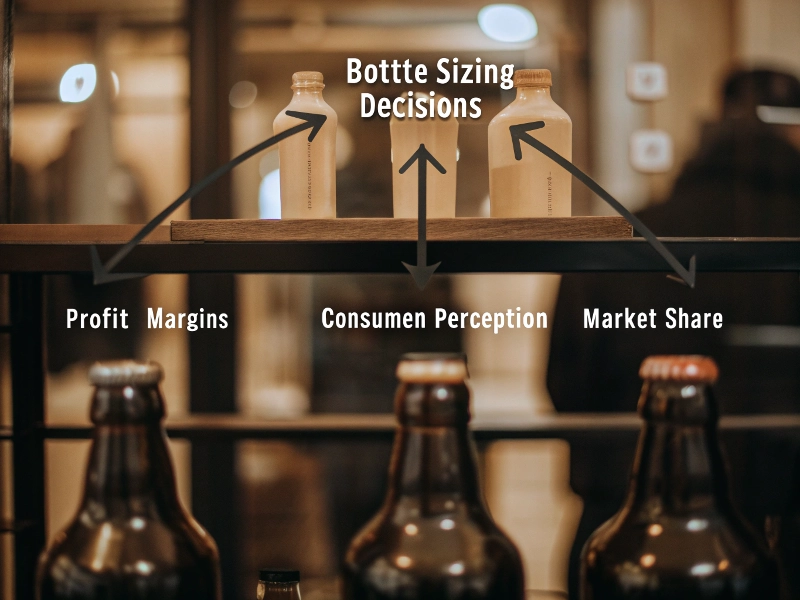
Let me break down exactly why your bottle size decisions matter more than you might think:
When it comes to branding and market positioning, size speaks volumes before your liquid touches a single lip. I worked with a premium whiskey brand that deliberately chose an unusual 375ml format with striking design elements—it screamed "craft" and "exclusive" while hitting a more accessible price point. Their per-ounce price was actually higher than competitors, but consumers perceived greater value because of the format.
Your cost structure gets dramatically affected too. The glass weight differences between sizes aren’t proportional—a 1.75L bottle uses less glass per ounce than a 750ml, but requires thicker walls to support the weight. One vodka brand I consulted with discovered their COGS on 50ml bottles was nearly three times higher per ounce than their 750ml, when factoring in glass, closures, labels, and filling inefficiencies.
Logistics considerations are where I see brands get blindsided most often. A craft rum producer I worked with switched from 750ml to 1L bottles without considering that their case count dropped from 12 to 6 bottles, their pallet configuration changed, and their freight costs jumped 22% overnight. Their distributors weren’t happy about the sudden change either.
Market access strategy is perhaps the most important angle. Different channels expect different sizes—bars often prefer 1L for popular spirits, duty-free retailers demand it, and club stores won’t even consider your product without a 1.75L option. One tequila brand I advised created a brilliant three-tier strategy: 50ml bottles for sampling events and hotel partnerships, 375ml for gift sets and trial, and 750ml for their core retail presence.
Finally, never underestimate regulatory considerations. The TTB’s Standards of Fill are non-negotiable, and getting this wrong means your product never reaches shelves, period. I’ve seen brands learn this lesson the hard way, with entire production runs rejected.
Which Standard Bottle Sizes Truly Align With Your Market & Production Reality?
Looking at a wall of options from your glass supplier can be overwhelming. Let me walk you through what each standard size actually means for your business strategy.
Each bottle size category serves specific market functions: Miniatures (50ml) excel at sampling and impulse purchases; Mid-size bottles (200-375ml) facilitate trial and gifting; Standard bottles (750ml-1L) form your core retail presence; and Bulk formats (1.75L) target value-conscious consumers and commercial accounts.

Miniature / Nip (50ml)
These little powerhouses aren’t just for airlines anymore. I’ve watched brands use 50ml bottles to create:
- Low-risk trial opportunities at checkout counters
- Luxury sampling programs for high-end spirits
- Hotel minibar placements that serve as brand billboards
- Gift set components and subscription box inclusions
- Event marketing tools that drive full-bottle purchases
Production-wise, they present unique challenges. The labeling is delicate work, sometimes requiring specialized equipment. Fill lines might need adjustments. But the marketing ROI can be tremendous—they’re essentially liquid business cards. One bourbon brand I worked with attributed 22% of their full-bottle sales directly to previous 50ml purchases.
Quarter Pint (100ml)
This niche size has limited applications but works well for:
- Travel retail multipacks
- Gift set components
- Premium sampling programs where 50ml feels insufficient
- Regional markets where this size has traditional relevance
It’s less common in standard production and often requires custom molds, which means higher MOQs and costs.
Half Pint (200ml)
This versatile in-between size balances trial and value, perfect for:
- Bar speed wells and restaurant back bars
- Budget-conscious consumer segments
- Travel retail and duty-free channel development
- Markets with strong cultural preferences for this size (parts of Europe and Asia)
While not as ubiquitous as 750ml, glass suppliers typically maintain standard molds for this size, making production runs accessible even for smaller brands.
Pint / "Jet" (375ml)
I’ve seen smart brands do incredible things with the 375ml format:
- Create gift-friendly premium packaging at half the price point
- Enter competitive categories with lower barrier to trial
- Build unique shelf presence through distinctive design
- Establish premium positioning while maintaining accessibility
- Test new markets with lower inventory commitment
Although the per-ounce cost is typically higher than 750ml, the absolute price point often hits psychological sweet spots under $20-25. Case counts typically run 12-24 units, optimizing distribution efficiency.
"Fifth" (750ml) – The Industry Standard
There’s a reason this remains the dominant format:
- Universal retail acceptance and consumer expectation
- Optimal balance of product quantity and price point
- Most efficient glass production economics
- Standardized shelf spacing in retail environments
- Maximum compatibility with existing production equipment
Nearly every glass supplier offers extensive standard mold options in this size, keeping MOQs lower and lead times shorter. If you’re choosing just one size, this is typically it—but that doesn’t mean it should be your only size.
Liter (1L)
This global player serves specific strategic purposes:
- Standard for duty-free and travel retail worldwide
- Preferred in many bar and restaurant programs for popular pours
- European market standard alongside 700ml
- Perceived value advantage over 750ml without jumping to bulky handles
Production considerations typically include slightly higher glass costs and potentially different case counts (often 6 or 12), affecting shipping economics.
"Handle" / Half Gallon (1.75L)
The value king carries strategic weight:
- Strong price-per-ounce value proposition for cost-conscious consumers
- Essential for club stores and volume retailers
- Standard for high-volume bar programs and commercial accounts
- Creates brand loyalty through less frequent purchase cycles
The operational impacts are significant—heavier glass, stronger packaging requirements, different pallet configurations, and potential bottling line adjustments. Retail placement is also specialized, with dedicated shelving areas for handles.
Understanding Key Terminology: "Fifth", "Handle", and Standards of Fill
I’ve seen costly confusion around these terms that every spirits professional should understand clearly.
The term "fifth" originates from being approximately one-fifth of a gallon, while "handle" refers to the literal handle on 1.75L bottles. These industry terms connect to Standards of Fill—legally mandated bottle sizes that vary by country and are non-negotiable for compliance.
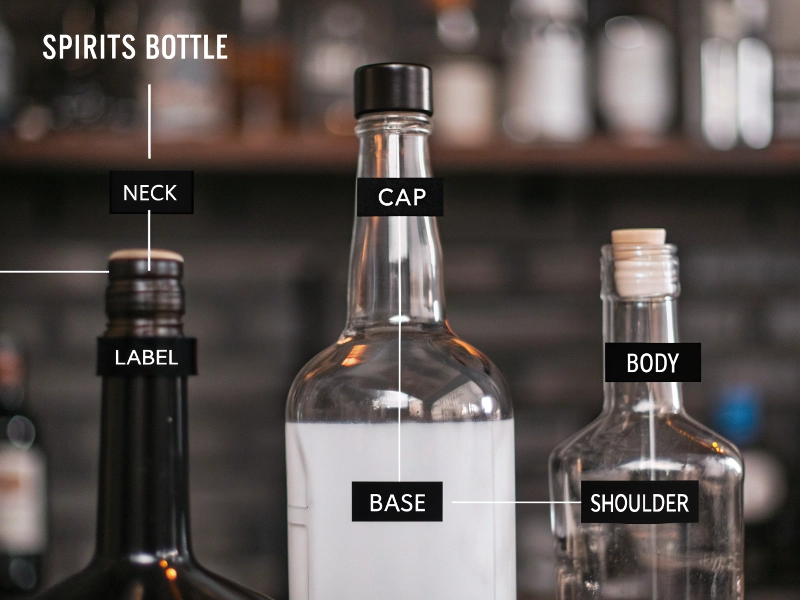
Let’s demystify these terms because I’ve seen miscommunication cause expensive problems:
"Fifth" refers to 750ml bottles because they contain roughly one-fifth of a gallon (757ml technically). The term stuck even as we moved to metric measurements. When communicating with suppliers, distributors, or regulators, precise measurements (750ml) are always preferable to colloquial terms.
"Handle" describes 1.75L bottles that typically feature a built-in handle for easier pouring given their weight. Again, in formal specifications, always use the exact volume measurement.
Most critically for your business, "Standards of Fill" are government-regulated bottle sizes that spirits must adhere to—no exceptions. In the US, the TTB (Alcohol and Tobacco Tax and Trade Bureau) strictly enforces these standards. Historically, approved sizes were limited, but 2020 regulations expanded options to include:
- 50ml, 100ml, 200ml, 375ml, 750ml, 1L, and 1.75L
- New additions: 700ml, 720ml, 900ml, and 1.8L
Despite these new options, industry infrastructure remains built around traditional sizes, making the newer options challenging to implement without specific strategic reasons.
Need to Compare Bottle Specs, Costs, and Uses Instantly?
When planning your product portfolio or talking with suppliers, this quick reference chart helps cut through confusion.
Reference this comprehensive comparison table to make informed decisions about which bottle sizes best match your specific market channels, pricing strategy, and operational capabilities.
| Size Name(s) | Capacity (mL) | Capacity (fl oz) | TTB Standard Fill | Typical Market Channel(s) | Common Case Count | Key Strategic Use |
|---|---|---|---|---|---|---|
| Miniature/Nip | 50mL | 1.7 oz | Yes | Retail checkout, Hotels, Events, Gift sets | 60-120 | Sampling, Brand introduction |
| Quarter Pint | 100mL | 3.4 oz | Yes | Travel retail, Gift sets | 48 | Premium sampling, Multipack offers |
| Half Pint | 200mL | 6.8 oz | Yes | Convenience stores, Travel | 24-48 | Value option, Travel convenience |
| Pint/"Jet" | 375mL | 12.7 oz | Yes | Retail, Gift market | 12-24 | Trial, Gifting, Price point access |
| "Fifth" | 750mL | 25.4 oz | Yes | All retail, Core offering | 6-12 | Standard purchase, Primary format |
| Liter | 1L | 33.8 oz | Yes | Duty-free, Bars, Europe | 6-12 | Value option, Bar program standard |
| "Handle" | 1.75L | 59.2 oz | Yes | Club stores, Value retail, Bars | 3-6 | Value proposition, Commercial use |
How Do You Ensure Your Bottle Size Choice is Strategic, Not Just Convenient?
After watching hundreds of brands succeed or struggle with their sizing decisions, I’ve developed this framework to guide strategic choice rather than defaulting to what’s easy.
Strategic bottle sizing requires a systematic evaluation of your target market, brand positioning, cost structure, production capabilities, distribution network, regulatory requirements, and product lifecycle stage. This framework prevents costly missteps and maximizes opportunity.
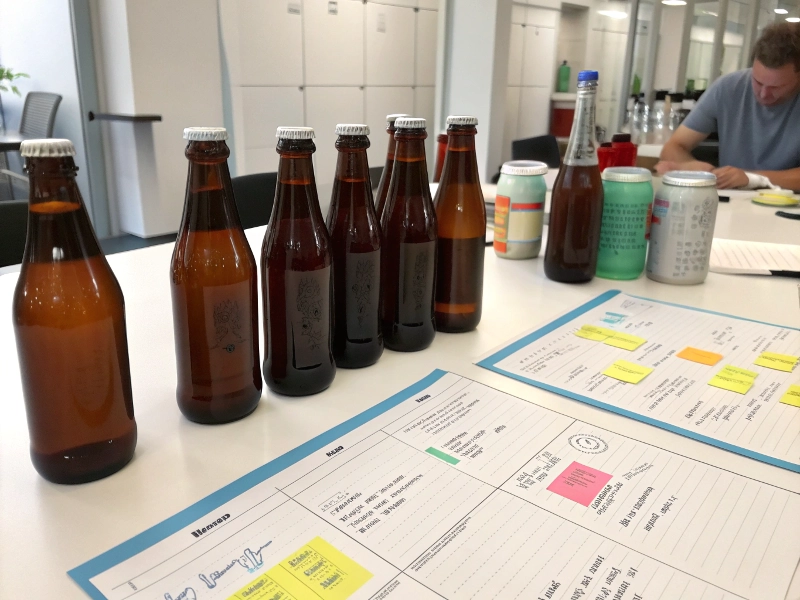
Here’s my step-by-step approach to make sure your bottle size decisions drive business success:
-
Define Target Market & Channel Strategy
Start by asking: Who am I selling to, and where will they buy? Different channels have different expectations. If you’re targeting high-end retail, 750ml is standard but 375ml creates gift opportunities. Bar programs often prefer 1L bottles for popular pours. Export markets might require different sizes entirely (700ml for Europe). Be clear about your primary and secondary channels before making any sizing decisions. -
Align with Brand Positioning & Product Tier
Your bottle size speaks volumes about your brand position. Ultra-premium spirits can leverage unique or smaller formats to justify higher per-ounce prices. Value brands need larger formats to communicate price advantage. One gin producer I worked with deliberately chose 375ml for their super-premium tier to make the absolute price point more accessible while maintaining premium per-ounce pricing. -
Analyze Cost Structure & Profitability Targets
Map out the complete COGS impact of different sizes. This includes not just glass costs, but closure differences, label sizing, filling efficiency, and packaging materials. Calculate your margins at different potential retail price points for each size. One vodka brand discovered their 1.75L offering was actually less profitable than their 750ml despite the volume advantage due to retail price compression. -
Evaluate Operational & Production Capabilities
Be honest about what your production line can handle efficiently. Changing sizes often means different bottling settings, labeling adjustments, or even different equipment. Consider minimum order quantities from your glass supplier—specialized sizes may require larger commitments. One craft distillery found they couldn’t efficiently fill 50ml bottles on their existing line, leading them to partner with a specialized co-packer for just that size. -
Assess Logistics & Distribution Network
Different sizes mean different case counts, pallet configurations, shipping weights, and warehouse space requirements. Ensure your distribution partners can accommodate your choices without creating friction. Calculate the landed cost impact across your distribution footprint. A tequila brand I consulted with discovered their shift to distinctive 1L bottles increased their shipping costs by 18% due to less efficient pallet utilization. -
Ensure Regulatory Compliance
Verify that your chosen sizes meet TTB Standards of Fill or equivalent regulations in your target markets. International distribution adds complexity here—what works in the US might not be legal in the EU or Asia. One bourbon brand had to scrap an entire production run when they discovered their custom 720ml bottle wasn’t yet approved for their target export market despite the 2020 TTB updates. -
Consider Product Lifecycle
Your optimal size mix will evolve as your brand matures. New brands might focus on trial sizes (50ml, 375ml) alongside a core 750ml offering. Established brands often expand to larger formats (1.75L) as they build customer loyalty and distribution strength. One successful tequila brand started with just 750ml, added 375ml in year two for gift sets, introduced 50ml in year three for sampling programs, and finally added 1.75L in year five when they had sufficient market presence.
Ready to Transform Your Bottle Size Selection into a Competitive Advantage?
After working with countless spirits brands on their packaging strategies, I’ve seen firsthand how the right sizing approach can become a powerful competitive edge.
Strategic bottle sizing isn’t just about containing your product—it’s about creating the ideal entry point for consumers, optimizing your cost structure, enhancing distribution efficiency, and reinforcing your brand positioning. Make these decisions with intention, not by default.
Your bottle size selection should never be an afterthought or simply "what everyone else does." The most successful brands I’ve worked with treat sizing as a core strategic decision that influences everything from trial to purchase frequency to brand perception.
Remember that there’s rarely a one-size-fits-all approach. The optimal strategy often involves multiple sizes working together to serve different market needs—50ml for sampling, 375ml for gift-giving and trial, 750ml as your core offering, and potentially 1.75L for value and volume consumers.
By applying the framework I’ve outlined and understanding the specific advantages and considerations of each size, you can build a bottle strategy that truly serves your business goals rather than limiting them. That’s how smart brands turn a basic packaging decision into a genuine competitive advantage.




